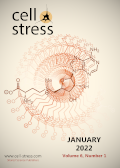Table of contents
Volume 6, Issue 1, pp. 1 - 16, January 2022
Rethinking the bioavailability and cellular transport properties of S-adenosylmethionine
Yudong Sun and Jason W. Locasale
Viewpoint |
page 1-5 | 10.15698/cst2022.01.261 | Full text | PDF |
Abstract
S-adenosylmethionine (SAM) is a versatile metabolite that participates in a wide range of reactions such as methylation and transsulfuration. These capabilities allow SAM to influence cellular processes such as gene expression and redox balancing. The importance of SAM is highlighted by its widespread usage as an over-the-counter nutrient supplement and as an experimental reagent in molecular biology. The bioavailability and cellular transport properties of SAM, however, are often overlooked under these contexts, putting limits on SAM’s therapeutic potential and complicating the interpretation of experimental results. In this article, we examined the chemical stability and cellular permeability of SAM, proposed a schematic for indirect SAM transport across the mammalian plasma membrane, and lastly discussed the implications arising from such transport schematic.
Evaluation of I-TAC as a potential early plasma marker to differentiate between critical and non-critical COVID-19
Yushan Zhang, Chao Xu, Nelson I. Agudelo Higuita, Resham Bhattacharya, Jennifer Holter Chakrabarty and Priyabrata Mukherjee
Research Articles |
page 6-16 | 10.15698/cst2022.01.262 | Full text | PDF |
Abstract
The COVID-19 pandemic has led to significant global health and economic consequences. There is an unmet need to define a molecular fingerprint of severity of the disease that may guide an early, rational and directed intervention preventing severe illness. We collected plasma from patients with moderate (nine cases), severe (22 cases) and critical (five cases) COVID-19 within three days of hospitalization (approximately one week after symptom onset) and used a cytokine antibody array to screen the 105 cytokines included in the array. We found that I-TAC, IP-10, ST2 and IL-1ra were significantly upregulated in patients with critical disease as compared to the non-critical (moderate and severe combined). ELISA further quantified I-TAC levels as 590.24±410.89, 645.35±517.59 and 1613.53±1010.59 pg/ml in moderate, severe and critical groups, respectively. Statistical analysis showed that I-TAC levels were significantly higher in patients with critical disease when compared with moderate (p = 0.04), severe (p = 0.03) or the combined non-critical (p = 0.02) group. Although limited by the low sample numbers, this study may suggest a role of I-TAC as a potential early marker to discriminate between critical and non-critical COVID-19 cases. Such knowledge is urgently needed for appropriate allocation of resources and to serve as a platform for future research towards early interventions that could mitigate disease severity and save lives.



